by Mary Ann Moore | Aug 25, 2021 | A Poet's Nanaimo
Wherever our ancestors lived, they gathered in circles around a fire. Through the years we’ve gathered in circles in various ways such as quilting, for prayer, women’s consciousness raising, for self-help and for honouring the changing seasons.
A poem by Danusha Lameris, “Small Kindnesses,” includes a reminder of how much we’re missing without the circle around the fire:
We have so little of each other, now. So far
from tribe and fire.
I began offering women’s writing circles in 1997 as a way to be together with our stories, each having an opportunity to be seen and heard. My motto when I began was: “Be seen. Be heard. Be amazed at what comes out of the stillness.”
In the writing circles I offer, we are a community, creating and celebrating in a form of ceremony that awakens and honours our own spirits and the seasons including the seasons of our lives. Now that September is approaching, it’s time to call the circle again, gathering women for sox-week circles to begin in person in Nanaimo on Wednesday, September 8 and via Zoom on Thursday, September 9. (I’ve included info about both circles at the end of this blog.)
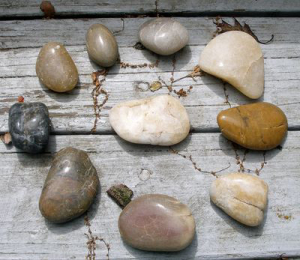 “I’ve always wanted to write but I don’t know where to start,” someone may say. “I don’t call myself a writer but I keep a journal,” someone else may say. All may have a longing for a place to be heard. In the Writing Life circle you are supported by guidelines that offer a structure to explore within, as well as by one another. You can honour and give voice to your longings and dive into the stories waiting to be told. Our stories, written and shared in the circle, take us into the realm of the sacred.
“I’ve always wanted to write but I don’t know where to start,” someone may say. “I don’t call myself a writer but I keep a journal,” someone else may say. All may have a longing for a place to be heard. In the Writing Life circle you are supported by guidelines that offer a structure to explore within, as well as by one another. You can honour and give voice to your longings and dive into the stories waiting to be told. Our stories, written and shared in the circle, take us into the realm of the sacred.
We are engaging in the ancient wisdom of the circle in a modern application. As Matthew Fox said in his book Creativity: “The building of strong souls and strong communities requires strong rituals – occasions that both link us to our ancestors and that speak in a language that is fresh and challenging.”
While there are many components to the circle such as connection, communication, compassion and curiosity, I’ve narrowed them down to ten.
The Ten Components of the Circle
Container
Writing is a ceremony. Ceremonies are meaning containers.
Gail Sher, The Intuitive Writer
The circle is a container, with a structure and circle agreements. As there is structure in a story, there is structure in the circle where we learn to stretch ourselves and also learn to pause. It is a simple yet powerful way to honour ourselves.
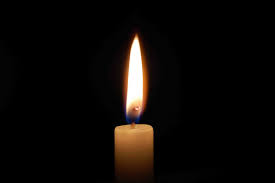 Ceremony
Ceremony
The candle is lit. Some sage may have been burned to clear the space. This holy smoke is an element of most spiritual practices of the world. The poetry and prose we create together defines our longing and creates a ceremony of stillness and consciousness.
Conversation
For all creativity is communication; it is the utmost in communication, the telling of our story, our hearts, our truth, our inner wisdom, our search for beauty, and our telling of pain.
Matthew Fox, Creativity
We live in a noisy era where the levels of sound increase as the needs of people to be heard become desperate. In the circle we sit down and listen with an intentional conversation.
Composting
What we may see as scraps for the compost pile can becoming nourishing for the soil/soul. The ideas percolate for awhile and as various elements come into assist them such as the support of others in the circle, sparkling imaginings can result. Out of the daydreams, are ideas for your own stories from life.
Calling the Circle
When I put the word out about a new writing circle, I don’t think of “marketing” but rather calling people back to the circle. “A circle is not just a meeting with the chairs rearranged. It is a return to an original form of human community, as well as a leap forward to create a new form of community,” Christina Baldwin says in Calling the Circle. “Calling the circle is a declaration of readiness to link where we came from, where we are, and where we may go.”
Coming Home
I read Christina Baldwin’s book on journaling, One to One, in the 1970s and went on to read her other books on journaling and on the circle. She is a pioneer in journaling and circle work. “I want to come home to the earth again,” she wrote. Simply sitting and listening to ourselves and one another can bring us home.
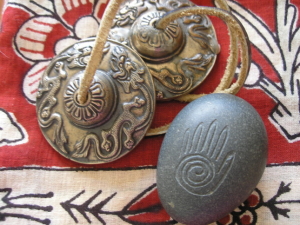 Centre
Centre
The centre of the circle where I’ve placed a candle, a talking piece, and the ting sha to ring our beginning represents the great good or great spirit. As we look to the centre of ourselves, we look to the centre of the circle for strength, guidance and wisdom. The centre of the circle is like the centre of the medicine wheel, a cauldron full of possibilities.
Creativity
“The Celtic imagination loved the circle,” John O’Donohue said. “It recognized how the rhythm of experience, nature, and divinity followed a circular pattern.” The circle is a place to get in touch with all the ways in which we are creative, to remember the joy we experienced from planting a garden or creating a collage of sticks and stones on the beach or by picking up a musical instrument. In the circle we may do some collage, take a walk to loosen the ideas, create paint chip poems or a group poem, and read a poem together one line at a time.
I like what Flora Bowley says in her book The Art of Aliveness: “Now, more than ever, applying the philosophies of the creative process to our lives and to our world is not only helpful, it’s vital.”
Community
Ideally, community is a place where we can meet with others wholeheartedly to celebrate our sameness and our differences. It’s a place where we get to live up to our full potential and are supported for it. In the circle we create a community where we learn what it’s like to be all we can be and we take those experiences into creating healthy communities in our neighbourhoods and workplaces.
Celebration
How wonderful it is to celebrate together as each woman is honoured and each rite of passage is acknowledged. “Won’t you celebrate with me,” Lucille Clifton said in her poem with that title.
won’t you celebrate with me
what i have shaped into
a kind of life? i had no model.
born in babylon
both nonwhite and woman
what did i see to be except myself?
i made it up
here on this bridge between
starshine and clay,
my one hand holding tight
my other hand; come celebrate
with me that everyday
something has tried to kill me
and has failed.
I look forward to gathering in the circle in Nanaimo as well as on Zoom with women who are further away. “Keep holding the hearth – these sometimes nearly invisible islands of calm and circle and feminine energy are the soul portals of the world at this chaotic and dangerous time,” Christina Baldwin wrote to me many years ago. How accurate those words are for us today.
There is a fire of welcome in my Nanaimo living room, although not a literal one, as well as on Zoom where we can see and hear one another to keep the embers glowing. It can become a sacred place.
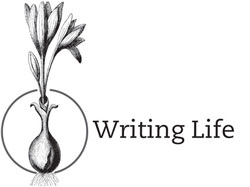 Writing Life women’s writing circles
Writing Life women’s writing circles
Nourish Yourself. Honour Your Voice. Write Your Stories.
Writing Life women’s writing circle in person in Nanaimo
Theme: Where Many Streams Meet
In the Writing Life women’s writing circle, you will find your voice and trust it as you’ll learn to trust the people on the journey with you. You’re not alone. Sing your song and dance your truth as you realize your stories as a place where many streams meet. Notes and handouts will be sent to those who happen to miss a week.
Wednesday, September 8 to Wednesday, October 13, 2021 from 10 a.m. to 12:30 p.m.
(six Wednesday mornings)
+ a Writing Life salon for sharing your work from the six-week writing circle on Wednesday, October 20
Fee: $270 payable by cheque or e-transfer
You can be in touch with questions or to save you a space in the circle by emailing me at creativity@maryannmoore.ca.
Writing Life women’s writing circle via Zoom
Theme: Where Many Streams Meet
In the Writing Life women’s writing circle, you will find your voice and trust it as you’ll learn to trust the people on the journey with you. You’re not alone. Sing your song and dance your truth as you realize your stories as a place where many streams meet. Handouts will be sent via email before each weekly circle. Notes will be sent to those who happen to miss a week.
Thursday, September 9 to Thursday, October 14, 2021 from 10 a.m. to 12:30 p.m. Pacific time
(six Wednesday mornings)
+ a Writing Life salon for sharing your work from the six-week writing circle on Thursday, October 21
Fee: $270 payable by cheque or e-transfer
You can be in touch with questions or to save you a space in the circle by emailing me at creativity@maryannmoore.ca.
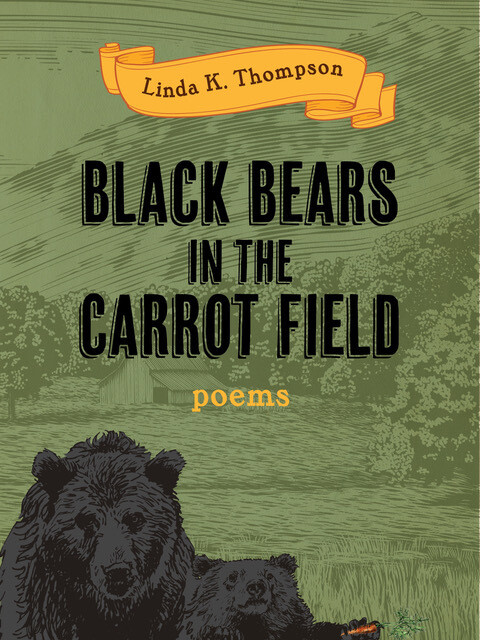
by Mary Ann Moore | Aug 2, 2021 | A Poet's Nanaimo
Isn’t that a great title for a poetry collection? Black Bears in the Carrot Field is Linda K. Thompson’s debut poetry collection, published in July 2021 by Mother Tongue Publishing on Salt Spring Island B.C.
The title comes from Linda’s poem “Saying Goodbye”:
My family back on the mainland are sleeping
tight beside tall rocks. Dreaming about black bears
in the carrot field, and the Eiffel Tower
that has appeared in the middle of the barnyard.
Yes, a blend of the practical and the imagined or rather, the metaphorical.
Linda includes some notes in the back of the book so we learn that Linda’s brother, Bruce Miller, told her that “his friend and fellow farmer, David Hellevang, told him the story of the black bears in the carrot field. David and his crew were in the front field digging potatoes and, unbeknownst to them, the bears were in the back field ripping through and chewing up his field of carrots. Such a metaphor for life, don’t you think? Sometimes you just can’t win for losing. But you keep on keeping on.” There’s Linda K. Thompson’s philosophy of life in a nutshell, or rather in a potato skin.
Linda kept on keeping on learning from various (and famous) poets, being encouraged by friends and family along the way and published her poems in several publications including her own chapbook entitled Four Small People in Sturdy Shoes (Hot Tomato Studios, 2013). Her work has recently appeared in Prairie Fire and Release Any Words Stuck Inside of You: Canadian Flash Fiction and Prose Poetry.
Among the teachers Linda makes note of is Susan Musgrave, another B.C. poet who spends most of her time on Haida Gwaii. In recent years, both Linda and I have attended poetry workshops with Susan and in 2006, I think it was, we attended Susan’s workshop at the Victoria School of Writing where we met.
Linda and I attended many poetry retreats with the late Patrick Lane who is acknowledged as providing Linda with the two opening lines to her poem “Near Nice, France – 1941:
A paper lies on my desk, one corner folded under.
I won’t want to write about love again.
At the end of her “thank-yous,” Linda says: “And to Patrick, who understood my poems best of all.”
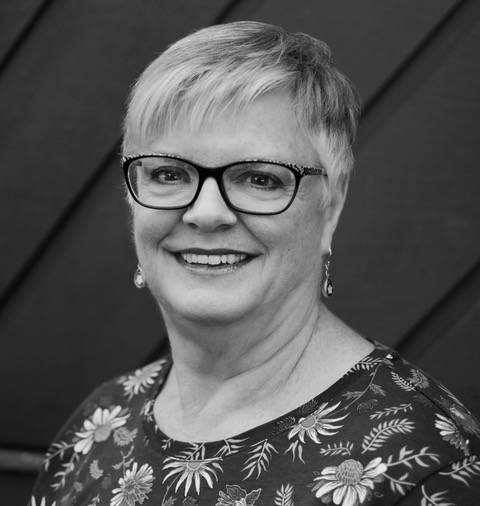 Patrick’s fellow poet in love and in life, Lorna Crozier, has been our teacher at retreats in recent years and Linda thanks Lorna for her “midnight ‘poetry intervention’ — shoring up my spirits when I might have stalled along the rocky road to publication.”
Patrick’s fellow poet in love and in life, Lorna Crozier, has been our teacher at retreats in recent years and Linda thanks Lorna for her “midnight ‘poetry intervention’ — shoring up my spirits when I might have stalled along the rocky road to publication.”
Linda was born in 1950 at Vancouver General Hospital and was raised on a potato and cattle farm in the Pemberton Valley, B.C., a flat river valley with rugged coast mountains rising sharply on both sides. As Linda says in her notes: “100 years later, Pemberton is well known for its superior seed potatoes.” Linda’s Great Uncle Jack Ronayne followed the suggestion of a Department of Agriculture representative who, in 1922, thought farmers ought to take advantage of “this unusual isolation to develop and grow a disease-free seed potato.”
Linda has lived for many years in Port Alberni on Vancouver Island.
I asked Linda about her poem “My Story Begins” and what she meant by “thimble babies / that left the house in the night,” and I should have figured who she is acknowledging as the next lines are:
brothers and sisters that never
quite took, but we loved them anyway,
like we loved the eggs in the hatcher:
for the mystery of them.
Just like “old home week” as we call it when we run into old friends, Linda names lots of them including a couple of cows, Bopper and Fudge, in her poem “Cows in the Family.”
Linda may have known Kathleen and Steve and of course her sister Janet. Other may have been made up but sure have a “real” ring to them such as Dick Black, Ethyl Peach and Bud Fournier in her poem “Bob’s House. (There was also a family English sheepdog named Bob when Linda was young.)
The places beyond Pemberton in Linda’s poems include Taos, New Mexico where Linda attended a poetry workshop and still recalled her father in the cottonwood. (“Courtyard in Taos”) “Near Nice, France – 1941” is written in the voice of Monique, one of Henri Matisse’s models.
“Buffalo in Yellowstone” describes the narrator with Bob (there he is again!) and she says:
I had lots of time
to think about old boyfriends, which I do now and then,
when I’m feeling life is less than I had expected.
As for “Gone to Windsor,” a prose poem, one never knows what is fact and what is made up. We poets do that sometimes i.e. make things up.
You can count on humour throughout Linda’s collection. That’s what we always looked forward to at poetry retreats when Linda would read a poem she had worked on, long into the night, the day before. “Ye Olde Burd Turd Grocery” is one of the places she notes in “Mr. Carlisle” as well as the “Cut to the Chase Beauty Salon.”
There is much poignancy too such as in “Bring This Stone to the Grave.” The title is beautiful and the poem is a gorgeous memory of the pastures, “last fall’s potato fields,” the orioles and waxwings, and a stone “smooth as one of Father’s old Viyellas. The last lines are:
Still, the sun across the cottonwoods that line the Lillooet
will nearly break your heart.
Wow.
Black and white photos throughout the book, like a family album, are from Linda’s collection as well as from Pemberton & District Museum & Archives Society. The first photo is of Linda as a baby with her parents: Elsie Glover and Don Miller. It was taken in 1950, as Linda notes, “near Kamloops on trip home from Vancouver to purchase a new Chev truck and drive it to Lillooet to be loaded on PGE and delivered to Pemberton. There was no road in or out till the mid 60s.”
The next photo is of Don and Elsie’s farm c.1975, “looking south towards Mount Currie from the farmhouse.” The photo acts as a background to Linda’s poem “Home Ground.”
Hippocrates believed humans absorb the topographical influence
of the place they are born and separation from this place
can be injurious to one’s health. Susan tells me this is called “vivaxis.”
I do not know the word. But I know the feeling.
What a marvelous collection of poems celebrating family and place. While letting us know about a particular locale in British Columbia, Canada, the poems can’t help but hearten readers to remember their own beginnings and the “topographical influence of a place”.
You can order a copy of Black Bears in the Carrot Field from your local independent bookstore or directly from Mother Tongue Publishing. There is free shipping within North America.
Linda has some B.C. readings coming up:
September 25 at the Pemberton Museum
October 2 at the Victoria Writers Festival
October 16 at the Gabriola Library with Bill Stenson
I’ll ask her if she has any plans for Windsor.
by Mary Ann Moore | Jul 25, 2021 | A Poet's Nanaimo
I wonder if it’s “the” writing life or “a” writing life? I suppose it’s “my” writing life I’m about to describe as while all writers write, each of us approaches our practice differently.
Annie Dillard called her book The Writing Life and I rather like that title so used it for this blog. There are obvious similarities among writers’ lives: we all write whether for publication or to record and explore life’s journey. Sometimes we don’t write but it’s writing that sustains us, nourishes us, keeps us connected to all that was, that is and that will be.
When writers say they’re writing, they could be creating new work or attending to the myriad of other aspects of their writing life. I like to call my “to do” list:
Passions + Possibilities.
Ideas
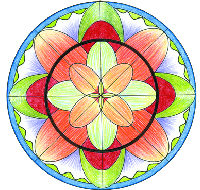 There are always ideas and one of those good ideas is to capture them in a notebook that can include questions and thoughts about future possibilities. Sometimes those ideas don’t take too long to become reality. I once created a small collage with a door and thought of a title for a poetry workshop: “Poetry as a Doorway In . . . and a Welcome Home.” Not too long after, I began offering writing circles at Bethlehem Centre in Nanaimo with that title and am now leading a Writing Life women’s writing circle with the same theme. The mandala shown at the left is titled “Come to Centre” and is by Sarah Clark. It’s the symbol I use for the “Poetry as a Doorway In” writing circles.
There are always ideas and one of those good ideas is to capture them in a notebook that can include questions and thoughts about future possibilities. Sometimes those ideas don’t take too long to become reality. I once created a small collage with a door and thought of a title for a poetry workshop: “Poetry as a Doorway In . . . and a Welcome Home.” Not too long after, I began offering writing circles at Bethlehem Centre in Nanaimo with that title and am now leading a Writing Life women’s writing circle with the same theme. The mandala shown at the left is titled “Come to Centre” and is by Sarah Clark. It’s the symbol I use for the “Poetry as a Doorway In” writing circles.
The “ideas” notebook could be a place to keep lists so they’re all in one place. I have a list for blog ideas, book review ideas, and ideas for future writing circles. And I still get ideas for a novel I wrote a long time ago called “Ordinary Life” as well as ideas and quotes for a personal essay I’m working on.
Already in the World
Writers are not necessarily good promoters of their own work but it must be done to let others know the work exists. Once the book is available, it needs to be nurtured along it’s path in the world otherwise know as publicity and marketing.
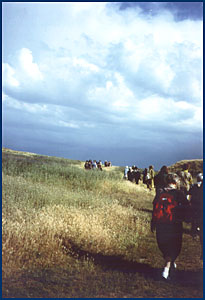 The image to the left is from the cover of Writing to Map Your Spiritual Journey, a writing resource I have available through the International Association for Journal Writing (IAJW). While it’s noted on my website and visitors to the IAJW site will see it, I do like to let people know, which I can, that it’s available. So I’ll provide a link right here, right now!
The image to the left is from the cover of Writing to Map Your Spiritual Journey, a writing resource I have available through the International Association for Journal Writing (IAJW). While it’s noted on my website and visitors to the IAJW site will see it, I do like to let people know, which I can, that it’s available. So I’ll provide a link right here, right now!
While Writing to Map Your Spiritual Journey is available digitally, I would also like to have print versions done. That will involve having some typos corrected and having the graphic designer, Mark Hand, get it ready for the printer.
Writing Home: A Whole Life Practice is already in the world as it’s a book that is part of a mentoring program I offer. I’m out of books though so need to do a second printing and I’d like to make it available for anyone i.e. without the need to be part of the mentoring program. That involves some tending to corrections as well which can be done with Sarah Clark who is my own in-house designer!
Proposals
When a project or poem is done, it’s time to send it out into the world. That seems a better plan to me than filing it away. There are other ways to share of course such as in a letter to a friend or in a circle of friends.
I have a collection of poems that I call “Modern Words for Beauty.” Many of them were started while on retreat with other poets so were shared in their earlier versions. I’ve been looking for a publisher for this second volume of my poetry. One of the “rejection” emails I received said said that writers must persist and indeed we must.
Praise
Every
Realization
Surely and
Instinctively: a
Soulful
Testament
I’m working on some personal essays and sending them out one-by-one to contests with literary journals. I like contests as there is a reasonable timeframe for hearing back. One of my essays began with an idea proposed to the co-editor at Freefall Magazine. I worked with Crystal MacKenzie over many months and my essay, “Frogs Fell from the Sky: Fiction in Poetry” appeared in the spring issue of Freefall. You can also read it online here.
One Main Project
Creativity coach Eric Maisel who is one of my fellow journal council members with the IAJW, says writers and artists ought to have one main project. That does make sense to me. While I work on individual essays that could become a collection and the other things noted above, my main project is “Inside the Treasure House: Ceremonies + Practices for Your Writing life.”
A Table of Contents is serving as my outline as I write about my writing life with passion and possibility. Writing is my anchor so sticking to it during the pandemic year was grounding and sustaining.
Journaling
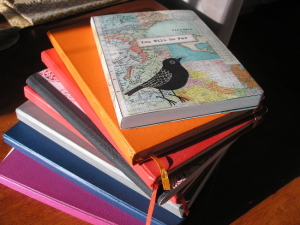 Whether I’m working on any of the above aspects of my writing life, journaling is at the foundation of all of it. It’s what I do first thing in the morning when I write down my dreams and ponder the day ahead. I begin with greeting my guides including the trees right outside my window and the mountain known as the Grandmother of All Surrounding Mountains to the Snuneymuxw people.
Whether I’m working on any of the above aspects of my writing life, journaling is at the foundation of all of it. It’s what I do first thing in the morning when I write down my dreams and ponder the day ahead. I begin with greeting my guides including the trees right outside my window and the mountain known as the Grandmother of All Surrounding Mountains to the Snuneymuxw people.
I often take a flower essence (which I offer in the writing circles as well). Right now, I’m taking a combination essence called “Following Desire” from Raven Essences. It’s made up of several flowers and other combinations including Gloxinia, Mock Orange, Cuban Hibiscus, Portia Tree, Castor Bean, Columbine and Sedum.
I usually pick a card or perhaps three from “On a Positive Note”, mandala meditation cards by Sarah Clark. I read a poem or some prose from an inspiring book. Lately I’ve been reading The Art of Aliveness: A Creative Return to What Matters Most by Flora Bowley (Hierophant, 2021). I appreciate Flora’s question: “In times of transition, circle back to this potent question: Would I rather be comfortable and stagnant or uncomfortable and alive?”
Journaling is what we do in the Writing Life women’s writing circle and much of it becomes part of longer pieces or poems that can be worked on and shared again. The same happens when journaling on my own. I take my writing from the writing table in my bedroom across the hall to my office where I have my computer and all sorts of books to which to refer in a beautiful space.
Aides to the Writing Life/A Basket of Tools
 All of these things, noted above, are aides to my writing life as well as a creative and supportive partner, a beautiful home in which to live and create, a regular income in the form of an Old Age Pension, and writing friends. Besides weekly writing circles, I like getting together with other women writers to chat. Literary events have been a great way to connect to other writers and I look forward to in-person events soon. (I am thankful for Zoom for the times when we couldn’t meet in person and as an added bonus, seeing people who live far away.) As I’ve been going to poetry retreats for a long time, I am part of a community of writers that will begin to meet again in person, possibly in the Fall.
All of these things, noted above, are aides to my writing life as well as a creative and supportive partner, a beautiful home in which to live and create, a regular income in the form of an Old Age Pension, and writing friends. Besides weekly writing circles, I like getting together with other women writers to chat. Literary events have been a great way to connect to other writers and I look forward to in-person events soon. (I am thankful for Zoom for the times when we couldn’t meet in person and as an added bonus, seeing people who live far away.) As I’ve been going to poetry retreats for a long time, I am part of a community of writers that will begin to meet again in person, possibly in the Fall.
This is another bonus to sending things out and having them published as books or in anthologies and literary journals. You get to share your work with other writers and readers and celebrate the written word together.
Flora Bowley writes about “Your Basket of Tools” in her book noted above: The Art of Aliveness. She says that her basket of tools “took many years of dedicated work and curiosity to acquire, and I’m so grateful I have them when I need them. At the same time, I’m careful to keep the basket behind me when I’m painting.” She doesn’t want to give the tools priority over her blank canvas. She wants to keep “the channel open between me and the uncertain unfolding of my current creation.”
“The blank canvas is where life unfolds,” Flora says. Her wisdom very much applies to writing. (She writes books too!) She finds “the most life-giving practice is to find a balance between our well-intentioned routines and the space we need to keep free for improvisation, surprise and change. We keep our basket of lived experience behind us, while keeping the path of possibility open before us.” I could also say: The blank page is where life unfolds.
by Mary Ann Moore | Jun 1, 2021 | A Poet's Nanaimo
I begin my day by journaling about my dreams and whatever those reflections lead to. Poems can begin that way too. It’s a beautiful threshold space, in between dreaming and waking.
When I offer a writing circle via Zoom on Thursday, June 3rd we’ll begin with a poem by Lorna Crozier: “A Good Day to Start a Journal.” From there we’ll write a journal entry about our day and move onto reading poems to inspire our own practice of “The Poetry of Presence.”
The writing circle is from 10 a.m. to 12 noon Pacific time on Zoom. I’m used to offering writing circles in the summer and this way, via Zoom, you can join wherever you may be. The fee is $45 payable by e-transfer or cheque. You can get in touch with me at creativity@maryannmoore.ca for further information and to register. Or have a look under “Poetry Circles.”
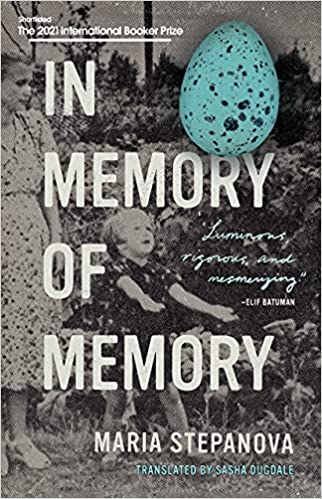 Recently, I began reading a book called In Memory of Memory by Maria Stepanova translated from the Russian by Sasha Dugdale (Book*hug Press, 2021) in which Stepanova writes of her late Aunt Galya who kept “countless used notebooks and diaries. She’d kept a diary for years; not a day passed without her scribbling a note, as much a part of her routine as getting out of bed or washing.”
Recently, I began reading a book called In Memory of Memory by Maria Stepanova translated from the Russian by Sasha Dugdale (Book*hug Press, 2021) in which Stepanova writes of her late Aunt Galya who kept “countless used notebooks and diaries. She’d kept a diary for years; not a day passed without her scribbling a note, as much a part of her routine as getting out of bed or washing.”
A diary can be kept as a “working tool” as Stepanova notes in relation to writer Susan Sontag. “Notebooks are an essential daily activity for a certain type of person, loose-woven mesh on which they hang their clinging faith in reality and its continuing nature. . . a notebook is a series of proofs that life has continuity and history, and (this is most important) that any point in your own past is still within your reach.”
Stepanova’s Aunt Galya made note of “daily occurrences, recorded with astonishing exactness, and with astonishing opacity. The diaries documented the time she got up and when she went to sleep, the television programs she’d watched, the number of phone conversations she’d had, who they’d been with, what she’d eaten, whatever else she’d done.”
These diaries weren’t reflections of an inner life and yet they seem to indicate a type of companionship or witness: this is what I did, this is what I will do, all proof I’m still here. It feels to me like a presence practice, the chronicling of the ordinary things in one’s day. Until her dying day, Aunt Galya wanted the diaries and notebooks close by even if simply, to touch them.
From October 11, 2005 [excerpted from “Someone Else’s Diary” in In Memory of Memory]
I rang the clinic. Ira from Social Services, and Yura in the evening. Watched television and tidied all the washing on the chair. Went to bed at 11:30 p.m.
Hot day. I wore the skirt Tonya got me. “Dreary sort of life, of no use to anyone,” as you might say. Tea in the afternoon, coffee in the evening. No appetite whatsoever.
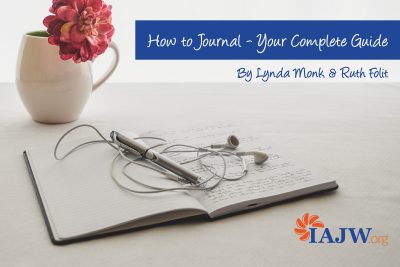 I’m a member of the Journal Council of the International Association for Journal Writing (IAJW) and have a couple of resources available for sale on the IAJW website. There are also many complimentary resources on the site, such as this blog article: How to Journal: Your Complete Guide to the Benefits of Personal Writing, which can be found here: https://iajw.org/how-to-journal-complete-guide/
I’m a member of the Journal Council of the International Association for Journal Writing (IAJW) and have a couple of resources available for sale on the IAJW website. There are also many complimentary resources on the site, such as this blog article: How to Journal: Your Complete Guide to the Benefits of Personal Writing, which can be found here: https://iajw.org/how-to-journal-complete-guide/
I suggest you have a look at all the IAJW has to offer. You can become a member or sign up for the newsletter which offers all sorts of inspiration for your journaling practice. I feel honoured to be one of the Journal Council members as my fellow writers on the council, have inspired me for many years.
In 1980 when I lived in Bowmanville, Ontario I wrote a column on Durham Region history for the Toronto Star. I put some of those articles into an engagement calendar I self-published called Durham Diary 1980. I still have my mother’s copy in which she recorded events and observations
March 8, 1980
M.A. and children came. It was great to see them. Rusty working as usual. Started to snow about 1:30 and they left at 3. Terrible drive home. Took 3 hours. We went to the Greens. Not very good & rather dull.
March 9, 1980
Guess what I did today?? Did the laundry – what else. This is called living? Hans will be home this week coming so no Margot.
Rusty was my husband at the time. Margot was my mother’s friend who was a great help to her (“really is my salvation”) as Mum was adjusting to an artificial leg which was extremely painful. She was also suffering from chest pains and had heart surgery the week of March 17, 1980. She has filled in “TGH” on many of the days . She crossed off several weeks in the calendar when she was at West Park Convalescent Hospital in Toronto.
As for poetry that begins in a journal, there is a difference between the two i.e. the journal entry and the crafted poem. Each word matters in the poem.
Jane Hirshfield says the difference between a journal entry and a poem is “the difference between a poet’s seeing and poetry’s seeing, and hearing, speech. One may help make the other possible, but they are not the same, in kind or intention – and the distinction exists because poetry itself, when allowed to, becomes with us a playable organ of perception, sounding out its own form of knowledge and forms of discovery. Poems do not simply express. They make, they find, they sound (in both meanings of that word) things undiscoverable by other means. “ (Ten Windows: How Great Poems Transform the World, Knopf, 2015)
I can see that journal excerpts whether my own or someone else’s such as my mothers’s, can make their way into a poem with some introspection and perhaps new discoveries on the part of the poet and from the poem itself.
The only way to tell you is to write
this down, our lives a journal
with notes about the weather, perhaps
a grocery list and appointments never kept
because the sparrows sing for seeds
in our apple tree, and the spider
at the centre of her web demands
your poet’s eye to hold her still.
from “A Good Day to Start a Journal” by Lorna Crozier
in The Blue Hours of the Day: Selected Poems (McClelland & Stewart, 2007)
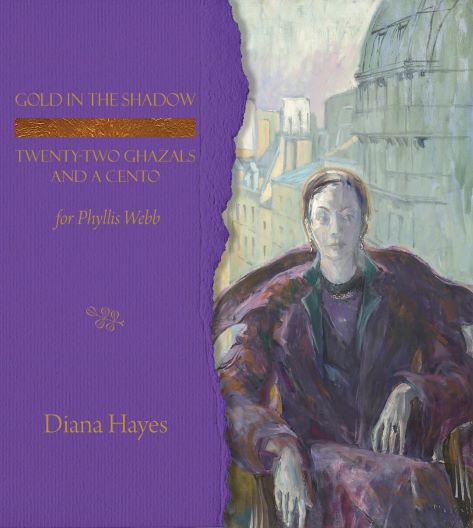
by Mary Ann Moore | Mar 21, 2021 | A Poet's Nanaimo
Diana Hayes new book of poetry, GOLD IN THE SHADOW: TWENTY-TWO GHAZALS AND A CENTO for Phyllis Webb (Rainbow Publishing, 2021), is exquisite in every detail: the design by Pat Walker Design and the papers used; the purple and gold of the cover; the size of the book; and the finely-rendered poetry written as a tribute to a beloved poet. Phyllis Webb will be 94 on April 8, 2021.
Diana Hayes and Phyllis Webb first met in 1980 and Phyllis “has been a mentor, friend, and a listening ear” to Diana. They both live on Salt Spring Island, British Columbia. Lorraine Gane, Diana’s editor, also lives on Salt Spring. Diana appreciates “walkabouts” she took with Lorraine as well as “the many insights and the courage to dive deeper into the work.”
The image that distinguishes the book’s cover is from an oil on canvas by Joe Plaskett entitled “Double Portrait of Phyllis Webb.” The frontispiece features both aspects of the double portrait, one of them a profile of Phyllis. Joe Plaskett’s studio in Paris was full of mirrors, Phyllis told Diana, and this may have led to the spontaneity of painting the two images. At first I thought the profile was of the aging poet looking to the youthful version of herself but as it turns out, Phyllis is the same age in both: 32 in 1959 when the painting was done.
As Diana describes them, the poems she has written are a personal expedition into Phyllis’s visual art and poetry. Diana began working on a “catalogue project” in 2017 to photograph Phyllis’s paintings and many of them opened the doors into the ghazals.
Diana’s introduction to the book of poetry, entitled “Night Journeys,” describes becoming intrigued by Phyllis’s visual art while also being a reader and collector of Phyllis’s poetry books. “The paintings,” Diana writes, “provided the maps for my journey into the ghazals. Lines from Phyllis’s poems echoed beyond horizons.”
What glorious night journeys Diana had in her writing studio built by her husband Peter Southam. “The ghazal was the official language of my nights,” Diana writes. Into the realm of poetry in the midst of the West Coast rainforest, Diana travelled to Paris, Egypt, Norway. There was opera at The Met, gods and goddesses, a monk and his lover, and many exotic flowers. A simply gorgeous introduction to the twenty-two ghazals she wrote.
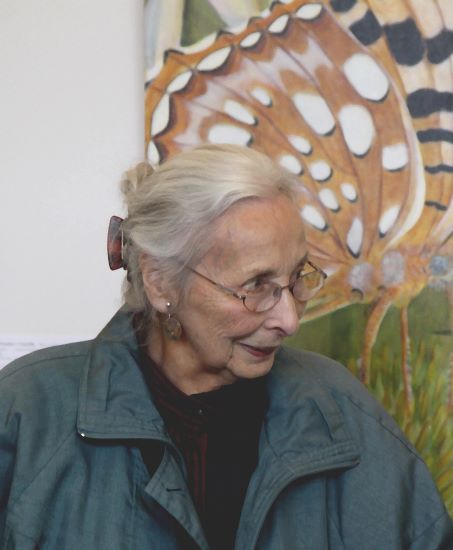 Diana has inhabited a form “that Phyllis Webb made her own – the ghazal in its Canadian variant pioneered by John Thompson – “ Erin Moure says in her endorsement of the book. While echoing the poems of Phyllis Webb, Diana’s ghazals “are perfectly themselves” says Eve Joseph in her endorsement. And indeed they are.
Diana has inhabited a form “that Phyllis Webb made her own – the ghazal in its Canadian variant pioneered by John Thompson – “ Erin Moure says in her endorsement of the book. While echoing the poems of Phyllis Webb, Diana’s ghazals “are perfectly themselves” says Eve Joseph in her endorsement. And indeed they are.
Black facing pages describe elements of the ghazals such as “the black roses of Halfeti” which are naturally occurring black roses which only grow in a small village in Turkey called Halfeti. They only appear black in the summer months.
The photo of Phyllis Webb is by Diana Hayes, Salt Spring Library, October 18, 2014.
Sometimes the explanations refer to a line from one of Phyllis’ poems or the title of one of her paintings. One of them,” Bronze Icon,” was a gift to Diana and her husband Peter on their wedding day, December 31, 2015. (There is an image of the painting in the book.)
The ghazal originated in Persia around the seventh century. One of its famous practitioners was Hafiz whose poetry many may know through the renderings, of Daniel Ladinsky.
“Originally, ghazals consisted of at least five but usually no more than twelve couplets (shers)” Kate Braid and Sandy Shreve explain in In Fine Form, 2nd Edition (Caitlin Press, 2016). Like traditional haiku, ghazals do not have titles. The couplets are so independent of each other, their order can be changed “without damaging the poem.”
One meaning of the word “ghazal” is “the talk of boys and girls” which can mean “sweet talk or verbal lovemaking” Edward Hirsch says in A Poet’s Glossary (Houghton, Mifflin, 2014). “The ghazal tends to blur the distinction between erotic and divine love,” Hirsch says.
The Urdu master of the ghazal, Ghalib (1797 – 1869), wrote:” There is a wilderness within a wilderness. I saw the desert and remembered home.”
Diana Hayes echoes that sentiment as she writes of her night journeys during “twenty-two nights, twenty-two ghazals” disembarking when she was home again as “the mad gardener of the Salish Sea.”
There is a sense of loss in Diana’s ghazals which is an aspect of one of the meanings of “ghazal”: “The cry of the gazelle when it is cornered in hunt and knows it must die.” (Hirsch)
As Ahmed Ali puts it, this explains “the atmosphere of sadness and grief that pervades the ghazal” as well as its “dedication to love and the beloved.” (as quoted by Hirsh)
In Diana’s Ghazal XIV, “Ennui has stolen the day, run off the with colours of dawn,” and in Ghazal XXII, “Grief is a two-legged crow hop, laughing . . “. And in the same poem, “acedia” is noted to refer to “a state of listlessness or torpor” that has been referred to “as the lost name for the emotion we are all feeling during the Covid-19 pandemic.” As the poet embarked on a journey, readers do as well with the ancient form depicting the travels and explorations of a life, and the very real sense of the present day.
Diana’s final couplet of Ghazal XXII reads:
The porter drops my valise on the studio steps.
Icons or encumbrance. To what world have I returned?
“A Cento for Phyllis” is made up of twenty-two lines of Phyllis Webb’s poetry from Water and Light: Ghazals and Anti Ghazals (Coach House Press, 1984) except for a couple of lines which are from “Mad Gardener To The Sea” in The Sea is Also A Garden (The Ryerson Press, 1962).
“Cento” is from the Latin word for “patchwork” and the form is a wonderful way to pay tribute to the poetry of a beloved poet. The combinations and juxtapositions of lines can be intriguing and delightful such as:
The purple orchid he brought me.
Coloured enough, though featherless.
The book is a wondrous accomplishment by one multi-talented and multi-disciplinary artist in homage to another. The limited edition book is multi-faceted and multi-layered, a rich journey of discovery with modern insights written in a traditional form.
Phyllis Webb was born in Victoria, B.C. in 1927. While at the University of British Columbia for her undergraduate degree in English and philosophy, she was encouraged in her vocation as a poet by Roy Daniells, Earle Birney and John Creighton. P.K. Page was “the one who made me feel I wanted to be a poet,” Phyllis said (as quoted by John F. Hulcoop in his introduction to Peacock Blue: The Collected Poems of Phyllis Webb (Talonbooks, 2014). F. R. Scott, a founding member of the CCF (Co-Operative Commonwealth Federation), was one of the men who influenced her and persuaded Phyllis to move to Montreal. She worked for the CBC interviewing poets and became executive producer of Ideas which she co-created with William Young.
Phyllis Webb’s final volume of poetry, Hanging Fire, came out in 1990. She was appointed an Officer of the Order of Canada in 1992. (Peacock Blue contains poems from Hanging Fire followed by uncollected and previously unpublished poems.)
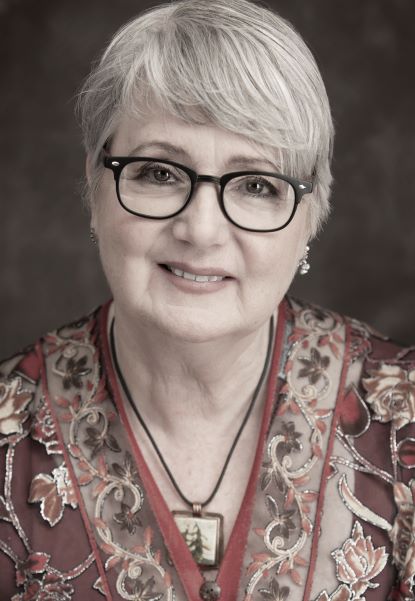 Diana Hayes has five published books including This is the Moon’s Work: New and Selected Poems (Mother Tongue Publishing) and Labyrinth of Green (Plumleaf Press).”Deeper Into the Forest,” a spoken word/music CD was produced at Allowed Sound Studio in 2020. Diana’s poetry has been included in several anthologies and her narrative photography has been featured in galleries in coastal B.C. Her practice of year-round swimming inspired the formation of the Salt Spring Seals in 2002. Diana has made Salt Spring Island home since 1981.
Diana Hayes has five published books including This is the Moon’s Work: New and Selected Poems (Mother Tongue Publishing) and Labyrinth of Green (Plumleaf Press).”Deeper Into the Forest,” a spoken word/music CD was produced at Allowed Sound Studio in 2020. Diana’s poetry has been included in several anthologies and her narrative photography has been featured in galleries in coastal B.C. Her practice of year-round swimming inspired the formation of the Salt Spring Seals in 2002. Diana has made Salt Spring Island home since 1981.
There will be a reading and celebration of GOLD IN THE SHADOW on Zoom on Saturday, March 27, 2021 at 7 p.m. To register for the event, email programs@saltspringlibrary.com.
To order a copy of GOLD IN THE SHADOW visit Diana Hayes’ website at www.dianahayes.ca.
The photo of Diana Hayes is by Ramona Lam.
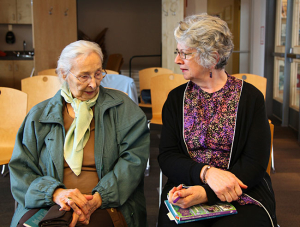
Phyllis Webb and Mary Ann Moore at the launch of Blue Halo by Lorraine Gane at the Salt Spring Library on Saturday, October 18, 2014. Photo: Diana Hayes. www.dianahayes.ca
by Mary Ann Moore | Mar 10, 2021 | A Poet's Nanaimo
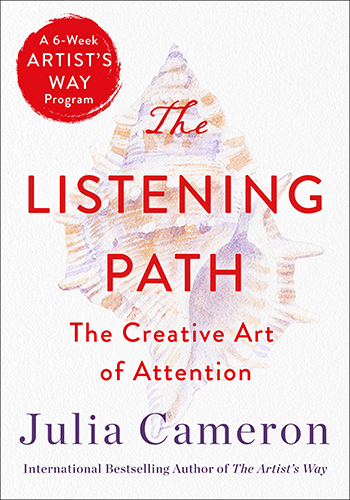 Julia Cameron has written a new book, The Listening Path: The Creative Art of Attention (St. Martin’s Essentials, 2021), which she describes as a 6-week Artist’s Way Program. Do you remember reading The Artist’s Way which helped many of us enter a “creative recovery” program for six weeks? It was first published in 1991. A 25th Anniversary edition came out in 2016.
Julia Cameron has written a new book, The Listening Path: The Creative Art of Attention (St. Martin’s Essentials, 2021), which she describes as a 6-week Artist’s Way Program. Do you remember reading The Artist’s Way which helped many of us enter a “creative recovery” program for six weeks? It was first published in 1991. A 25th Anniversary edition came out in 2016.
In her new book, Julia reminds readers of “the basic tools” from The Artist’s Way: Morning Pages, Artist Dates and Walks.
Morning Pages are a way to listen to ourselves each morning “thus clearing the way for further listening through the day.” To write “morning pages” is a daily practice of writing three pages in a stream-of-consciousness way, when first waking up. As Julia says: “We learn to trust that each word is perfect – good enough and even better than that.”
Anything and everything that crosses your mind is what goes into Morning Pages.
With Artist Dates “we listen to the youthful part of ourselves who craves adventure and is full of interesting ideas,” Julia says.
With Morning Pages, we focus “our attention on the problem at hand. With Artist Dates, we practice release, and our minds fill with new ideas. It takes the ‘letting go’ for the process to work.”
The Artist Date is a way to woo your artist self and is something you do on your own each week. While there are restrictions these days when it comes to art galleries, bookstores and the like, in our area we can visit bookstores while masked. Visiting the children’s section of a bookstore would be a fun Artist Date. There are amazing children’s books full of colour and stories to lift your spirits.
In downtown Nanaimo, there’s a small art gallery called Gallery Merrick. A visit to Joe and the art he has arranged by various artists would be a fun Artist Date. A fabric store, art store, craft supply store, or garden centre could be other possibilities. There may be gardens in your area that would be a good Artist Date where you could be on the look-out for signs of spring.
The Artist Date is a time to visit “something you love” and “come home to yourself,” Julia says.
Walks are a way to “listen both to our environment and to what might be called our higher power or higher self.”
Walking is the third tool as it’s a way to untangle “our often tangled lives” Julia says. Many spiritual traditions practice walking such as Buddhists with their walking meditation. It’s the form of meditation I prefer over sitting.
 Julia says writing is indeed “a form of active listening.” For that reason, I’m using the theme of “The Listening Path” for the next Writing Life women’s writing circle that begins on March 31st. (Have a look under “Circles” for the Writing Life Circle (via Zoom) or for “Writing Life “from away” (via email).
Julia says writing is indeed “a form of active listening.” For that reason, I’m using the theme of “The Listening Path” for the next Writing Life women’s writing circle that begins on March 31st. (Have a look under “Circles” for the Writing Life Circle (via Zoom) or for “Writing Life “from away” (via email).
In her book, Julia describes her days in Sante Fe as she writes about Listening to Our Environment, Listening to Others, Listening to Our Higher Self.
In the chapter on Listening Beyond the Veil, Week 4, Julia quotes Johann Wolfgang Von Goethe: “The world is so empty if one thinks only of mountains, rivers & cities; but to know someone who thinks & feels with us, & who, though distant, is close to us in spirit, this makes the earth for us an inhabited garden.”
What a lovely phrase: “an inhabited garden.” Indeed, the memories of my parents, beloved aunts and uncles, friends and cats who have all passed on do inhabit my garden, my little part of the earth.
Listening to “the world beyond the veil,” Julia says, requires “spiritual openness.” She says: “All that is required is that we open the door. And so we write: ‘Can I hear from X?’”
She keeps in touch this way with two women friends who have passed on. Julia asked about something specific and it was if she was taking dictation as she “heard” the answer.
“But, Julia, what if your responses from the afterlife are just wishful thinking?” If so, her “wishful thinking” had led her in a positive direction, Julia says. “There can be no harm in the positive. The contact bolsters our self-worth.”
Week 5 is “Listening to Our Heroes” and one of Julia’s is Bill Wilson, co-founder of Alcoholics Anonymous. She has also connected to Carl Jung who answered her in a cooler way than Bill: “Ms. Cameron, you are on track. You have much to offer. You can express yourself well. Right now you are replenishing your stocks. There is much to be said for a deep, quiet life.” He actually recommended to Julia that she read Anais Nin!
Many years ago when I was teaching a creative writing class in Guelph, Ontario, I suggested that we write some advice from a beloved writer or artist. “Do you always do channeling in your classes,” a student later asked me. I hadn’t thought of it that way. Perhaps I was channeling advice directly from Frida Kahlo when I wrote a poem called “Frida’s Advice” but I thought of it as my vivid imagination and the knowledge I had of the late Mexican artist. Whatever the explanation, it is fun to do. I’ve included my poem, “Frida’s Advice,” below.
The final week or chapter 6 of The Listening Path is “Listening to Silence.” I so appreciate the silence in a poem – all that white space beyond each line where we take a pause. My poetry mentor, Patrick Lane, will have a new book of poetry released from Harbour Publishing in the Fall: The Quiet in Me.
“Most commonly, I’m told that stopping and listening to silence brings a sense of calm and possibility. For me, I know that is true,” Julia says. In each of her chapters she has “Try This” sections and in this chapter she suggests finding a quiet environment and noting your resistance to the silence and perhaps the feeling of missing out by turning off all devices. “Try making this a regular habit. Like any habit, it can become more natural with practice.”
When someone has died we offer a minute of silence, in remembrance. When someone is suffering a loss, we sit with them, no advice needed, in silence.
While we won’t necessarily follow Julia’s “Try This” sections in the writing circles, I have all sorts of ideas based on her weekly themes. I look forward to exploring them on my own and with others.

Fishing for Mermaids (Leaf Press, April 2014)
Frida’s Advice
Ask me why people are so fascinated with
my crazy life, mi vida loca,
and I answer:
it’s the combination of sinister blues, yellow love, gangrene
the difference they see as exotic,
my body,
of work
the flame in the pain.
I was in anguish and
originality,
the smell of the paint, the brush
in my hand –
transcended the pain.
I say:
Go to the centre of the fire.
See what’s there.
It may not be as hot as you think.
It may be blue cold.
Write in bed.
Surround yourself with what matters.
Explore red.
Come to Mexico.
Read Octavio Paz.
Free yourself from the still life.
As for my pain
it was always there
but an angel with cut-lace wings kept me breathing
kept me examining every fissure
on my face,
every symbol of my lineage
every radical expression
left in me.
I will write to you with my eyes, always.
“Frida’s Advice” won third prize in the Book Shelf’s Annual Poetry Contest and was published in the May/June 2005 issue of Off the Shelf, Guelph, Ontario. It is also included in Fishing for Mermaids (Leaf Press, 2014).
 “I’ve always wanted to write but I don’t know where to start,” someone may say. “I don’t call myself a writer but I keep a journal,” someone else may say. All may have a longing for a place to be heard. In the Writing Life circle you are supported by guidelines that offer a structure to explore within, as well as by one another. You can honour and give voice to your longings and dive into the stories waiting to be told. Our stories, written and shared in the circle, take us into the realm of the sacred.
“I’ve always wanted to write but I don’t know where to start,” someone may say. “I don’t call myself a writer but I keep a journal,” someone else may say. All may have a longing for a place to be heard. In the Writing Life circle you are supported by guidelines that offer a structure to explore within, as well as by one another. You can honour and give voice to your longings and dive into the stories waiting to be told. Our stories, written and shared in the circle, take us into the realm of the sacred. Ceremony
Ceremony Centre
Centre Writing Life women’s writing circles
Writing Life women’s writing circles

 Patrick’s fellow poet in love and in life, Lorna Crozier, has been our teacher at retreats in recent years and Linda thanks Lorna for her “midnight ‘poetry intervention’ — shoring up my spirits when I might have stalled along the rocky road to publication.”
Patrick’s fellow poet in love and in life, Lorna Crozier, has been our teacher at retreats in recent years and Linda thanks Lorna for her “midnight ‘poetry intervention’ — shoring up my spirits when I might have stalled along the rocky road to publication.” There are always ideas and one of those good ideas is to capture them in a notebook that can include questions and thoughts about future possibilities. Sometimes those ideas don’t take too long to become reality. I once created a small collage with a door and thought of a title for a poetry workshop: “Poetry as a Doorway In . . . and a Welcome Home.” Not too long after, I began offering writing circles at Bethlehem Centre in Nanaimo with that title and am now leading a Writing Life women’s writing circle with the same theme. The mandala shown at the left is titled “Come to Centre” and is by Sarah Clark. It’s the symbol I use for the “Poetry as a Doorway In” writing circles.
There are always ideas and one of those good ideas is to capture them in a notebook that can include questions and thoughts about future possibilities. Sometimes those ideas don’t take too long to become reality. I once created a small collage with a door and thought of a title for a poetry workshop: “Poetry as a Doorway In . . . and a Welcome Home.” Not too long after, I began offering writing circles at Bethlehem Centre in Nanaimo with that title and am now leading a Writing Life women’s writing circle with the same theme. The mandala shown at the left is titled “Come to Centre” and is by Sarah Clark. It’s the symbol I use for the “Poetry as a Doorway In” writing circles. The image to the left is from the cover of Writing to Map Your Spiritual Journey, a writing resource I have available through the International Association for Journal Writing (IAJW). While it’s noted on my website and visitors to the IAJW site will see it, I do like to let people know, which I can, that it’s available. So I’ll provide a link
The image to the left is from the cover of Writing to Map Your Spiritual Journey, a writing resource I have available through the International Association for Journal Writing (IAJW). While it’s noted on my website and visitors to the IAJW site will see it, I do like to let people know, which I can, that it’s available. So I’ll provide a link  Whether I’m working on any of the above aspects of my writing life, journaling is at the foundation of all of it. It’s what I do first thing in the morning when I write down my dreams and ponder the day ahead. I begin with greeting my guides including the trees right outside my window and the mountain known as the Grandmother of All Surrounding Mountains to the Snuneymuxw people.
Whether I’m working on any of the above aspects of my writing life, journaling is at the foundation of all of it. It’s what I do first thing in the morning when I write down my dreams and ponder the day ahead. I begin with greeting my guides including the trees right outside my window and the mountain known as the Grandmother of All Surrounding Mountains to the Snuneymuxw people. Recently, I began reading a book called In Memory of Memory by Maria Stepanova translated from the Russian by Sasha Dugdale (Book*hug Press, 2021) in which Stepanova writes of her late Aunt Galya who kept “countless used notebooks and diaries. She’d kept a diary for years; not a day passed without her scribbling a note, as much a part of her routine as getting out of bed or washing.”
Recently, I began reading a book called In Memory of Memory by Maria Stepanova translated from the Russian by Sasha Dugdale (Book*hug Press, 2021) in which Stepanova writes of her late Aunt Galya who kept “countless used notebooks and diaries. She’d kept a diary for years; not a day passed without her scribbling a note, as much a part of her routine as getting out of bed or washing.” I’m a member of the Journal Council of the International Association for Journal Writing (IAJW) and have a couple of resources available for sale on the IAJW website. There are also many complimentary resources on the site, such as this blog article: How to Journal: Your Complete Guide to the Benefits of Personal Writing, which can be found here:
I’m a member of the Journal Council of the International Association for Journal Writing (IAJW) and have a couple of resources available for sale on the IAJW website. There are also many complimentary resources on the site, such as this blog article: How to Journal: Your Complete Guide to the Benefits of Personal Writing, which can be found here: 
 Diana has inhabited a form “that Phyllis Webb made her own – the ghazal in its Canadian variant pioneered by John Thompson – “ Erin Moure says in her endorsement of the book. While echoing the poems of Phyllis Webb, Diana’s ghazals “are perfectly themselves” says Eve Joseph in her endorsement. And indeed they are.
Diana has inhabited a form “that Phyllis Webb made her own – the ghazal in its Canadian variant pioneered by John Thompson – “ Erin Moure says in her endorsement of the book. While echoing the poems of Phyllis Webb, Diana’s ghazals “are perfectly themselves” says Eve Joseph in her endorsement. And indeed they are. Diana Hayes has five published books including This is the Moon’s Work: New and Selected Poems (Mother Tongue Publishing) and Labyrinth of Green (Plumleaf Press).”Deeper Into the Forest,” a spoken word/music CD was produced at Allowed Sound Studio in 2020. Diana’s poetry has been included in several anthologies and her narrative photography has been featured in galleries in coastal B.C. Her practice of year-round swimming inspired the formation of the Salt Spring Seals in 2002. Diana has made Salt Spring Island home since 1981.
Diana Hayes has five published books including This is the Moon’s Work: New and Selected Poems (Mother Tongue Publishing) and Labyrinth of Green (Plumleaf Press).”Deeper Into the Forest,” a spoken word/music CD was produced at Allowed Sound Studio in 2020. Diana’s poetry has been included in several anthologies and her narrative photography has been featured in galleries in coastal B.C. Her practice of year-round swimming inspired the formation of the Salt Spring Seals in 2002. Diana has made Salt Spring Island home since 1981.
 Julia Cameron has written a new book, The Listening Path: The Creative Art of Attention (St. Martin’s Essentials, 2021), which she describes as a 6-week Artist’s Way Program. Do you remember reading The Artist’s Way which helped many of us enter a “creative recovery” program for six weeks? It was first published in 1991. A 25th Anniversary edition came out in 2016.
Julia Cameron has written a new book, The Listening Path: The Creative Art of Attention (St. Martin’s Essentials, 2021), which she describes as a 6-week Artist’s Way Program. Do you remember reading The Artist’s Way which helped many of us enter a “creative recovery” program for six weeks? It was first published in 1991. A 25th Anniversary edition came out in 2016.